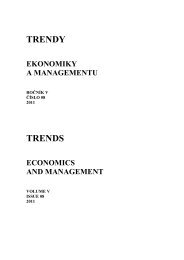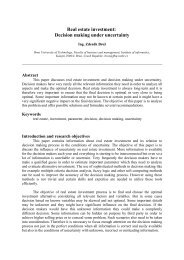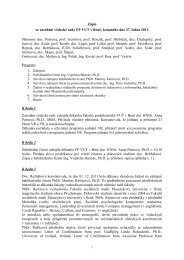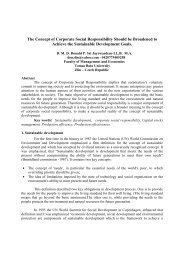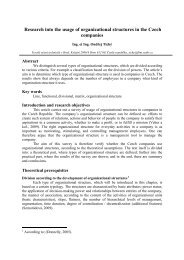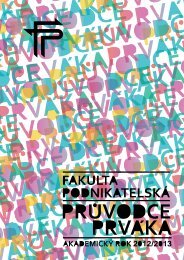Stáhnout toto číslo ve formátu PDF - Fakulta podnikatelská - Vysoké ...
Stáhnout toto číslo ve formátu PDF - Fakulta podnikatelská - Vysoké ...
Stáhnout toto číslo ve formátu PDF - Fakulta podnikatelská - Vysoké ...
You also want an ePaper? Increase the reach of your titles
YUMPU automatically turns print PDFs into web optimized ePapers that Google loves.
TRENDY EKONOMIKY A MANAGEMENTU / TRENDS ECONOMICS AND MANAGEMENT<br />
message or service. Some examples of tools used<br />
in eCRM:<br />
• Personalized Web Pages where customers<br />
are recognized and their preferences are<br />
shown.<br />
• Customized products or services.<br />
The impact of the Internet as a source of<br />
information as well as the task of consumer<br />
views and opinions about particular products or<br />
companies are not omissible. Therefore the<br />
Internet is getting into the position of the other<br />
communication canal between a company and its<br />
customers as well as customers mutually.<br />
Howe<strong>ve</strong>r, in a world where almost e<strong>ve</strong>ry<br />
company is connected to the Internet, eCRM has<br />
become a requirement for survival, not just a<br />
competiti<strong>ve</strong> advantage (Turban, 2008).<br />
4 Customer analytics and forecasting<br />
According to Fox (2008), more and more<br />
companies are in<strong>ve</strong>sting in understanding<br />
customer value and modeling customer behavior.<br />
As such, through the use of analytics, businesses<br />
now ha<strong>ve</strong> a comprehensi<strong>ve</strong> way of capturing data<br />
and learning more about the customer, their<br />
spending habits, and much more. Businesses<br />
require an increasingly personalized relationship<br />
with their customers, and customers are<br />
demanding highly individualized experiences<br />
with the companies they deal with. According to<br />
Greenberg (2008), businesses must ha<strong>ve</strong><br />
knowledge of their customers, not just some<br />
random demographic data. Customer knowledge<br />
(behaviours, emotional states, etc.) are<br />
increasingly more germane to what it takes to<br />
retain customer loyalty (Greenberg, 2008).<br />
5 Social CRM<br />
As social networking and Web 2.0 ha<strong>ve</strong><br />
proliferated in recent years, so a new branch of<br />
customer relationship management has grown.<br />
Social CRM (sometimes referred to as CRM 2.0)<br />
integrates social media and social networking<br />
platforms such as Twitter, Facebook, LinkedIn<br />
and YouTube into customer relationship<br />
management. By using social networking tools,<br />
companies can test new ideas with the consumer<br />
and get their feedback. In addition to<br />
communicating through many different forums,<br />
users can communicate about many different<br />
topics—including what products they'<strong>ve</strong><br />
purchased and how they rate them. Organizations<br />
are welcoming Web 2.0 as a means of helping<br />
them to impro<strong>ve</strong> their product and ultimately<br />
their brand. Customers are demanding a higher<br />
degree of interactivity from customer-service<br />
departments (Leary, 2008). As a result,<br />
companies are being challenged to add online<br />
capabilities to their CRM systems. Blogs,<br />
forums, wikis and other social-networking tools<br />
can all help companies reach out to customers<br />
and boost business.<br />
The first step in relationship is<br />
traditionally the campaign (one specific message<br />
that is deli<strong>ve</strong>red through specific channels in a<br />
time frame to the prospects). This first step using<br />
the social networks would be the content as a<br />
tool to generate con<strong>ve</strong>rsations and meaningful<br />
relationships. In the traditional CRM divides the<br />
customers in the sales cycle but in the social<br />
CRM is based in a collaborati<strong>ve</strong> relationship<br />
creating value for oursel<strong>ve</strong>s (Nieto, 2009).<br />
CRM has been oriented to the<br />
operational: the automation of processes through<br />
technologies and programs that are designed to<br />
make the employees of a business more effecti<strong>ve</strong><br />
and efficient in the management of relationships<br />
with customers. Typically customer insight was<br />
used as data, rather than the other way around<br />
(data being used to ascertain customer insight).<br />
This concept is now undergoing dramatic<br />
transformation. Social model of CRM where<br />
customers increasingly expect access,<br />
transparency, honesty and collaboration with the<br />
companies that they choose to do business with.<br />
Customers expect of e<strong>ve</strong>ry institution (be it<br />
business, political or social) is that it will ha<strong>ve</strong><br />
the products, services, tools and experiences they<br />
need to sculpt an individualized relationship with<br />
the company – personalized (and personal) in the<br />
way that they want it. As a result, CRM <strong>ve</strong>ndors<br />
are beginning to incorporate social tools such as<br />
wikis, blogs, social networks and Web 2.0<br />
applications into the CRM systems they offer.<br />
Companies like IBM, Intel and e<strong>ve</strong>n Cisco are<br />
offering pure collaborati<strong>ve</strong> systems so that<br />
practitioners (the <strong>ve</strong>ndors’ customers) can offer<br />
the le<strong>ve</strong>l of interaction that customers demand<br />
(Greenberg, 2008).<br />
6 Situation in Slovak enterprises<br />
From March 2007 to February 2009 we<br />
carried out the research specialized in diagnostics<br />
of the le<strong>ve</strong>l of Slovak companies in the CRM<br />
area. For better understanding the value of the<br />
– 22 –<br />
ROČNÍK IV – ČÍSLO 06 / VOLUME IV – NUMBER 06



